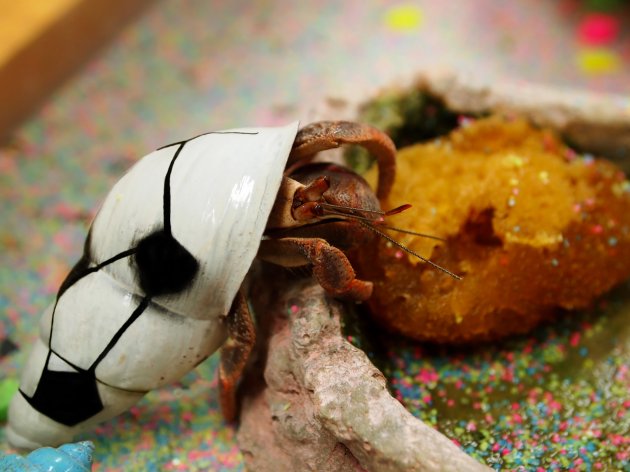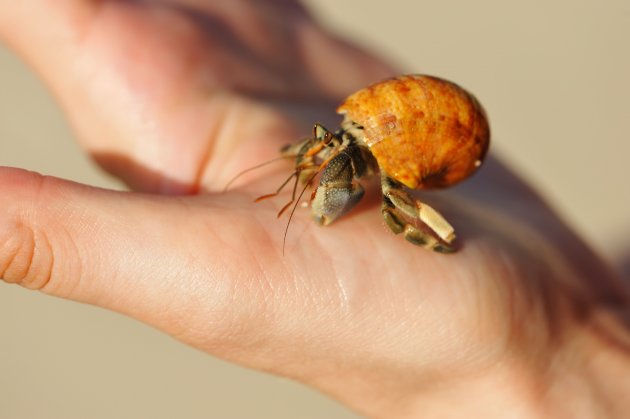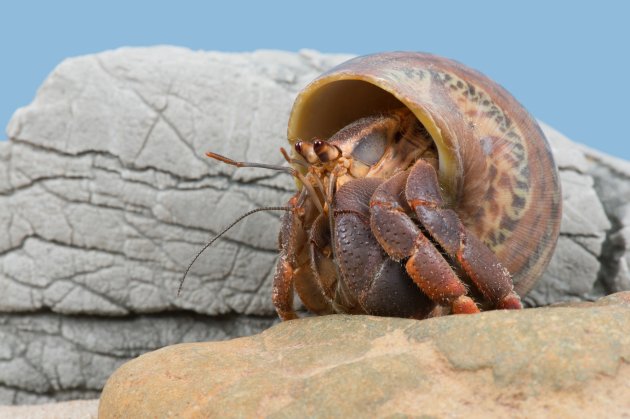Interested in keeping exotic pets? Then hermit crabs might just be the option you are looking for. Although not very social to human beings, they can be excellent pets and are one of the most interesting animal species to observe and collect. They are small and don’t require much space. Just a little maintenance can keep them alive for a long time.
They are basically two types of hermit crabs, one being aquatic and the other terrestrial. While terrestrial hermit crabs are mostly preferred as pets, aquatic ones are also a good option. In any case, if you really want to get pet hermit crabs, then consider the pros and cons before making a final decision.

Pros
Pros of owning pet hermit crabs are discussed below.
Lifespan
One of the first things that you need to consider before buying a pet is its lifespan. Pet hermit crabs usually survive longer in captivity, when compared to living in the wild. They are small creatures and hence fall easy prey to larger predators, such as birds and snakes.
The average lifespan of a pet hermit crab is estimated to be between 5 to 15 years. However, there have been cases where a pet hermit crab has lived for more than 30 years. So, this proves the fact that even if the average lifespan is low, with proper care they can live much longer.
Size
Hermit crabs are usually very small, but it all depends on the species type. There are almost 1100 different hermit crab species, out of which only 120 species are commonly adopted.
Ecuadorian crab, which is a very common pet hermit crab species, can only grow up to 12mm or ½ inch in size. This is one of the smallest hermit crab species. While a Caribbean crab, which is another common pet hermit crab, can grow up to 6 inches in size. In any case, most of the common pet hermit crabs are small and don’t require much home space.
Small Enclosure and Low Maintenance
Since hermit crabs are usually small in size, they do not require a big enclosure to hold them. A small aquarium for two crabs, while a medium-sized aquarium for three to four crabs would do just fine. In case if you want more than four, then you may have to buy a larger enclosure accordingly.
Hermit crabs’ needs are very low maintenance. They don't eat much but require a good amount of warmth and humidity. The humidity keeps their gills wet allowing them to breathe normally. You can achieve this by misting, or by simply keeping a wet sponge in their enclosure.
Apart from this, it is important to change the food and water dishes regularly, which hardly takes a minute or two. Also, the enclosure needs to be completely cleaned once a month. If the cleaning part is ignored for a long time, they can start smelling really bad.
Easy to feed
Hermit crabs make such good pets, mainly because it's easy to keep them and extremely easy to feed them. They are naturally omnivorous or herbivorous and can eat almost anything offered. There are plenty of commercial food mix brands available for them and are easily available at any pet store.
The best part about feeding hermit crabs is that the food can be delayed. As already mentioned, they don’t need much food. Therefore, a little carelessness in serving food on time is not at all an issue for our crabby friends.
Very Exciting to Observe
Hermit crabs come in many different species, sizes and colours. They are interesting creatures, who are good climbers and can burrow deep. You can keep artificial plants in the enclosure so that the pets can climb; and add a layer of moist soil as a substrate to help them burrow.
They are very curious creatures who enjoy climbing, foraging and exploring. In the wild, they thrive in large colonies and like sleep piled in a single area. They even collaborate in teams to find food. With all these amazing personality traits, it is just so exciting to observe hermit crabs go on with their day.

Cons
The cons of having pet hermit crabs are discussed below.
Not very social to Humans
While hermit crabs are social to other hermit crabs, they do not interact much with human beings. It is not risky or dangerous to handle them, instead, it is more like a personality trait. When handled, they crawl over the human body but do not respond to any human callings. They are very curious about their surroundings, but not so curious about humans.
Lots of Molting
Hermit crabs are ever growing creatures. However, their skin is not stretchable and hence, they need to shed their skin through moulting. For moulting they require more space, therefore, they need to burrow under some deep and damp sand.
If this moulting space is not provided to them, it can hinder their growth. Without proper space to moult, their growth comes to a halt and they remain that way till death. To avoid this, place a good substrate that allows them to dig deep down and moult. Using wet sand is a good idea, but avoid using gravel as it may be difficult for them to dig.
Apart from this, during moulting they are vulnerable. So, make sure that it doesn't get hurt or start fighting with another crab during this process. If another crab is picking a fight with a moulting hermit crab, then you need to separate them. You can do this by carefully pulling the attacking crab out to an isolated area, till the other crab is done with its moulting.
Special care for shells
Hermit crabs need shells to protect their not so strong abdomen and exoskeleton. They choose a shell that fits their size and live within it. However, every time they grow bigger, they leave their current shell and look for a bigger one. Therefore, you need to take special care in placing shells of various sizes in the enclosure.
Also, make sure to keep at least two shells of each size. Hermit crabs tend to fight for their homes. If there is only one suitable shell for two of them, a fight is inevitable with the weaker crab risking his life. But with two shells of each size, each of them can have one.
Apart from this, it is also important to keep varying sizes of shells, going from small to big with the diameter of their opening. If only smaller shells are kept, then it can greatly affect their growth.
They can smell bad
Maintaining a hermit crab is very inexpensive. It only requires a little amount of food and a complete cage cleaning once a month. However, if the cleaning is not done for a long time, they can start smelling really bad.
Need a lot of humidity
Hermit crabs need a lot of humidity to keep their gills wet. This allows them to breathe naturally on the land. Therefore, humidity levels need to be monitored once in a while. Ignoring this factor can significantly shorten the lifespan of your pet hermit crab.
The water needs to be chlorine free
Hermit crabs need special attention when it comes to water. The water you are providing regularly should be completely chlorine free. The chlorine in the water can slowly poison them, because of which their lifespan will decrease drastically.
You need at least two
For most people who think that only one hermit crab is enough for the house, they are wrong. Hermit crabs are happiest and most active when they have friends. You can keep a single hermit crab as a pet, but there is a good chance that it will have a short lifespan. Therefore, it is recommended that you buy at least two hermit crabs, to begin with.
Also, take special care while choosing them. It is better to pick two hermit crabs of the same size. Mainly because there is a good chance that the larger one may bully the smaller crab. If you want to avoid useless crab fights, make sure they are equal in size.

Are Hermit Crabs good pets?
Hermit crabs fall under the category of unusual pets. Unlike other crab varieties, they do not have a strong exoskeleton. Instead, they have a soft abdomen, which they protect by living in empty snail shells.
They are ever growing creatures and shift into bigger shells each time they grow. Therefore, owners need to take special care in providing a significant number of shells of various sizes to allow the pet hermit crab to choose their home comfortably.
They are very active, curious and exhibit various personality traits. In the wild, they are omnivorous and survive both on plant and animal food. They thrive in large groups and even will collaborate in teams to find food.
The most appealing factor for keeping pet hermit crabs is that they require very little maintenance. All you need to do is change food and water dishes regularly, and clean the enclosure completely once a month. Thanks to this, they make very easy-care companions.
Conclusion
There is a wide range of hermit crab species to choose from. They are available in various sizes, colours and personality traits. They are easy to care and do not require any special attention except humidity levels and shell care. If all this sounds very appealing to you, then hermit crabs are an excellent pet option for you.
References and further readings:
- Kelli A. Wilkins, 2007, Hermit Crabs For Dummies(Buy Book)
- Sue Fox, 2000,Hermit Crabs (Complete Pet Owner's Manuals) (Buy Book)
- Tufts University, Marine Hermit Crabs in Action
- Seattle Aquarium, Hermit Crabs
- PETA,7 Reasons Why You Should Never Buy a Hermit Crab